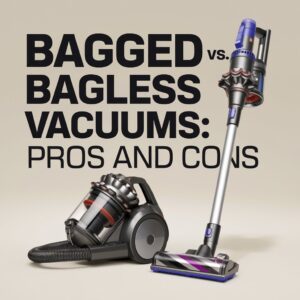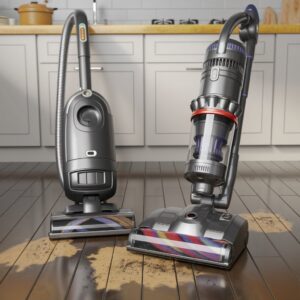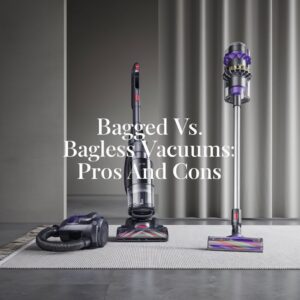Bagged vs. Bagless Vacuums: Pros and Cons
Choosing the right vacuum for your home can be tough. The debate between bagged and bagless models is ongoing. Each type has its own benefits and drawbacks. This guide will help you understand the pros and cons of each to make a better choice.

Understanding the Basics
Bagged Vacuums: These use bags to catch dirt and debris. When the bag is full, you need to replace or empty it.
Bagless Vacuums: These vacuums have a dustbin to collect debris. You empty it when it’s full. They also have filters to catch fine particles.
Advantages of Bagged Vacuums
1. Superior Filtration
Bagged vacuums are known for their great filtration. Their bags trap dust, allergens, and particles well. Many have HEPA-certified bags for better air quality.
2. Hygienic Disposal
Bagged vacuums are cleaner to dispose of. The bags are sealed, keeping dust and allergens inside. This is good for people with asthma or allergies.
3. Low Maintenance
Bagged vacuums need less filter cleaning or replacement. The bags filter the air, which helps the vacuum last longer.
4. Consistent Performance
As the bag fills, the vacuum’s suction stays strong. The sealed system keeps suction power steady, even with more debris.

Disadvantages of Bagged Vacuums
1. Recurring Costs
Buying new bags can cost a lot over time. While each bag is cheap, the total cost can be high for those watching their budget.
2. Limited Availability
Finding new bags for older vacuums can be hard. This is especially true if the manufacturer stops making the bags.
3. Environmental Impact
Disposable vacuum bags add to waste. This makes bagged vacuums less green than bagless ones.
Advantages of Bagless Vacuums
1. Cost-Effective
Bagless vacuums save money because you don’t need to buy new bags. Just empty the dustbin when it’s full.
2. Eco-Friendly
Bagless vacuums are better for the environment. They don’t use disposable bags, which reduces waste.
3. Transparency
The dustbins in bagless vacuums are clear. This lets you see when it’s time to empty it. It also helps you find any items you accidentally vacuumed up.
4. Wide Range of Models
Bagless vacuums come in many designs and prices. This gives you more options to choose from.
Disadvantages of Bagless Vacuums
1. Messy Emptying Process
Emptying a bagless vacuum can be messy. It may release dust and allergens back into the air. This is a problem for people with allergies.
2. Higher Maintenance
Bagless vacuums need frequent cleaning of filters and the dustbin. If you don’t clean them often, they won’t work as well.
3. Potential for Odors
Dust and debris in the canister or filters can cause bad smells. You’ll need to clean them regularly to avoid this.
4. Initial Cost
Even though they save money on bags, bagless vacuums with good filters can cost more at first.

Comparative Analysis
| Feature | Bagged Vacuums | Bagless Vacuums |
|---|---|---|
| Filtration | Superior, especially with HEPA bags | Adequate with proper maintenance |
| Hygiene | Clean and sealed disposal | Dust exposure during emptying |
| Cost Efficiency | Recurring cost for bags | No recurring bag costs |
| Maintenance | Low, bags handle filtration | High, frequent filter cleaning |
| Eco-Friendliness | Generates more waste | More sustainable |
| Performance Stability | Consistent as bag fills | Can drop if filters clog |
Factors to Consider When Choosing
1. Health Concerns
If allergies or respiratory issues are a concern, a bagged vacuum with a HEPA filter is better. It keeps allergens contained.
2. Budget
On a tight budget? Bagless vacuums save money by not needing bag replacements. But remember, they need more maintenance and filter replacements.
3. Convenience
Bagged vacuums are easier to empty and clean less often. Bagless models need more upkeep but tell you when they’re full.
4. Eco-Friendliness
For those who care about the environment, bagless vacuums are better. But some bagged models now use biodegradable bags.
5. Home Size and Usage
In larger homes or with heavy use, bagged vacuums might be better. They can hold more debris before needing to be emptied.
Innovations in Vacuum Technology
New technology is making bagless vacuums better. They now have self-cleaning filters and better dust containment. Bagged vacuums are also getting eco-friendly bags.
Conclusion
Choosing between bagged and bagless vacuums depends on your needs and lifestyle. Bagged vacuums are great for those who value cleanliness and ease of use. Bagless vacuums are good for saving money and being eco-friendly.
Think about the pros and cons to find the right vacuum for your home. It should make cleaning easy and efficient for years.